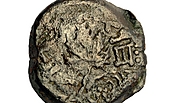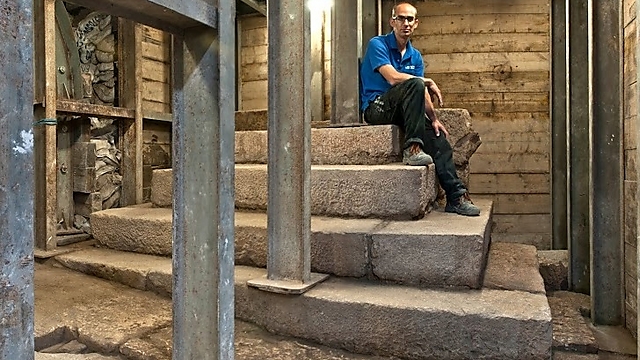
Coin from the time of the Great Revolt
צילום: קלרה עמית, באדיבות רשות העתיקות
Second Temple stairs discovered
Jerusalem dig uncovers mysterious podium and pyramid-like staircase built two millennia ago, apparently used by pilgrims en route to the Second Temple.
A pyramid-like flight of stairs built 2,000 years ago and apparently used by pilgrims to the Second Temple was recently discovered in Jerusalem's City of David National Park.

The stairs lead to a unique podium unlike any discovered previously. The find was made by the Antiquities Authority in cooperation with the Nature and Parks Authority and the Ir David Foundation.
The structure, which is made of hewn stone, is located at the side of a graded road from the Second Temple era, and appears to have been used by pilgrims going from the Pool of Siloam to the temple.

Dr. Joe Uziel, co-director of the excavation, with the unique structure (Photo: Shai Halevy/Israel Antiquities Authority) (צילום: שי הלוי, באדיבות רשות העתיקות)
Part of the road, which is made of huge stone slabs, was already exposed in the past and apparently passes over an ancient drainage canal that drained rainwater and was fully excavated several years ago.
The road was built in the fourth decade of the first century CE, and was one of the largest building projects in Jerusalem in that era. It was discovered underneath ruins that contained artifacts from the time of the Great Revolt against the Romans, which led to the destruction of Jerusalem in 70 CE.
Dozens of complete pottery vessels, stone tools, and glassware were found at the base of the staircase. "The structure exposed next to the road is singular," archaeologists Nahshon Zenton and Dr. Joe Uziel, directors of the dig, agreed. "We have never found anything like it in the many digs that have occurred in Jerusalem, and as far as we know even outside of Jerusalem, and because of that it's difficult to state its purpose with certainty."
The archaeologists said they believed the structure served as a podium to help draw the attention of passersby. "It's interesting to ask what was announced here – were messages from the government declared? Perhaps news and juicy gossip, or rebukes and street classes?"
Nineteenth-century British archaeologists Frederick Bliss and Archibald Dickie discovered part of the structure a century ago, but thought it was the entrance to the destroyed temple.
Zenton and Uziel will present their findings and possible interpretations on Thursday at an Ir David Foundation conference.










